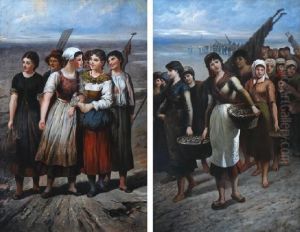F.J. Hoyer Paintings
Friedrich Johann Hoyer, commonly known as F.J. Hoyer, was a notable German artist whose work spanned the first half of the 19th century. Born in 1801 in Germany, Hoyer lived through a period of significant political, social, and artistic changes in Europe. His contributions to the art world, though perhaps not as widely recognized as some of his contemporaries, offer a fascinating glimpse into the styles and themes that characterized German art during this era. Hoyer's artistic endeavors were primarily focused on painting, where he demonstrated a keen interest in both portraits and landscapes, reflecting the romantic tendencies of the time.
His work often depicted the natural beauty of the German countryside, imbued with a sense of romanticism that was prevalent among artists and poets of his generation. Hoyer was deeply influenced by the Romantic movement, which emphasized emotion and individuality, a reaction against the industrial revolution and the rationalism of the Enlightenment. This influence is evident in his landscape paintings, which are characterized by their dramatic use of light and shadow, a technique that helped convey the emotional intensity and sublime beauty of nature.
In addition to landscapes, Hoyer also made significant contributions to portraiture. His portraits are notable for their detailed representation of the subject's character and mood, a testament to his skill in capturing the essence of human emotion and personality. These works provide valuable insights into the styles and fashions of the 19th-century German bourgeoisie, as well as the artistic techniques and conventions of the time.
While F.J. Hoyer may not have achieved the same level of fame as some of his contemporaries, his work remains an important part of the study of 19th-century German art. His paintings can be seen as a bridge between the classical traditions of the past and the emerging modernist movements that would come to dominate European art in the late 19th and early 20th centuries. Hoyer passed away in 1871, leaving behind a legacy that continues to be appreciated by art historians and enthusiasts alike for its contribution to the rich tapestry of European art history.
